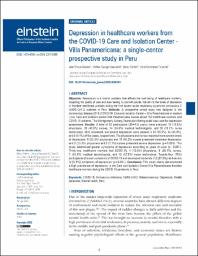Mostrar el registro sencillo del ítem
Depression in healthcare workers from the COVID-19 Care and Isolation Center - Villa Panamericana: a single-center prospective study in Peru
| dc.contributor.author | Moya-Salazar, Jeel | es_ES |
| dc.contributor.author | Saciga-Saavedra, Walter | es_ES |
| dc.contributor.author | Cañari, Betsy | es_ES |
| dc.contributor.author | Contreras-Pulache, Hans | es_ES |
| dc.date.accessioned | 2022-10-20T15:58:04Z | |
| dc.date.available | 2022-10-20T15:58:04Z | |
| dc.date.issued | 2022-04-13 | |
| dc.identifier.uri | https://hdl.handle.net/20.500.13053/6880 | |
| dc.description.abstract | Objective: Depression is a mental problem that affects the well-being of healthcare workers, impacting the quality of care and even leading to commit suicide. We aim to the levels of depression in frontline healthcare workers during the first severe acute respiratory syndrome coronavirus 2 (SARS-CoV-2) outbreak in Peru. Methods: A prospective cohort study was designed in the coronavirus disease 2019 (COVID-19) Care and Isolation Center – Villa Panamericana in eastern Lima. Care and Isolation Center-Villa Panamericana houses about 150 healthcare workers and COVID-19 patients. The Montgomery-Asberg Depression Rating scale was used for depression assessment. Results: A total of 96 participants (30±5.6 years) were analyzed: 15 (15.6%) physicians, 39 (40.6%) nurses, 14 (14.6%) medical technologists, and 28 (29.2%) nurse technicians. Mild, moderate, and severe depression were present in 35 (36.5%), 44 (45.8%), and 9 (9.4%) of the cases, respectively. The physicians and nurses reported more severe levels of depression: 8 (53.3%) physicians and 18 (46.2%) nurses presented moderate depression; and 2 (13.3%) physicians and 3 (7.7%) nurses presented severe depression (p=0.005). This study determined greater symptoms of depression according to years of work (p=0.001). Thirty-two healthcare workers had COVID-19, 4 (12.5%) physicians, 9 (28.1%) nurses, 7 (21.9%) medical technologists, and 12 (37.5%) nurse technicians. Twenty-four (75%) participants showed symptoms of COVID-19 and developed moderate (12 [37.5%]) and severe (3 [9.4%]) symptoms of depression (p=0.041). Conclusion: This study clearly demonstrated a high prevalence of depression in the Care and Isolation Center-Villa Panamericana frontline healthcare workers during the COVID-19 pandemic in Peru. | es_ES |
| dc.format | application/pdf | es_ES |
| dc.language.iso | eng | es_ES |
| dc.publisher | NLM (Medline) | es_ES |
| dc.rights | info:eu-repo/semantics/openAccess | es_ES |
| dc.rights.uri | https://creativecommons.org/licenses/by/4.0/ | es_ES |
| dc.subject | COVID-19; Coronavirus infections; SARS-CoV-2; Betacoronavirus; Depression; Health personnel; Mental health; Peru | es_ES |
| dc.title | Depression in healthcare workers from the COVID-19 Care and Isolation Center - Villa Panamericana: a single-center prospective study in Peru | es_ES |
| dc.type | info:eu-repo/semantics/article | es_ES |
| dc.identifier.doi | https://10.31744/einstein_journal/2022AO6707 | es_ES |
| dc.type.version | info:eu-repo/semantics/publishedVersion | es_ES |
| dc.publisher.country | BR | es_ES |
| dc.subject.ocde | http://purl.org/pe-repo/ocde/ford#3.03.00 | es_ES |
Ficheros en el ítem
Este ítem aparece en la(s) siguiente(s) colección(es)
-
SCOPUS [380]


